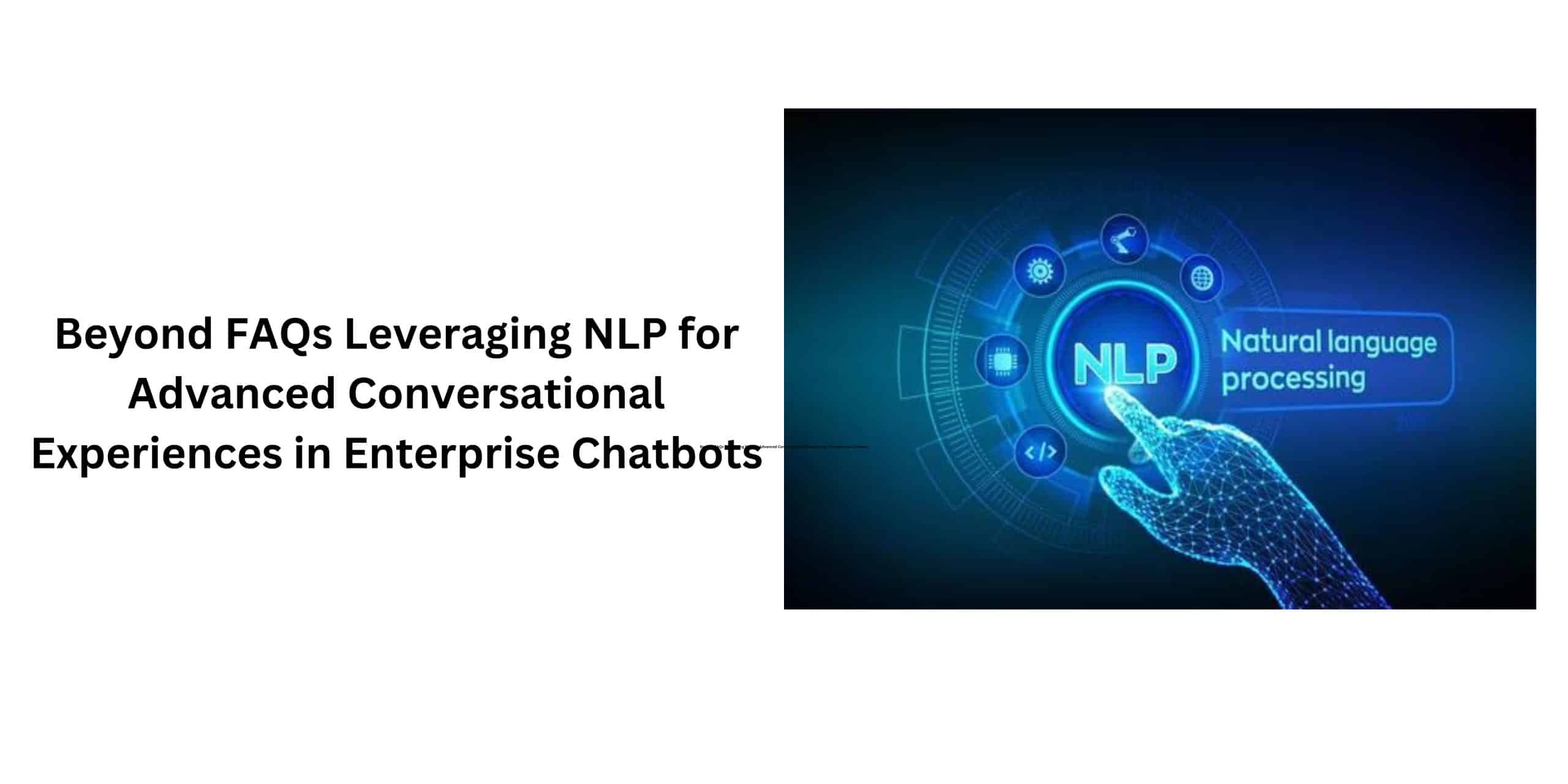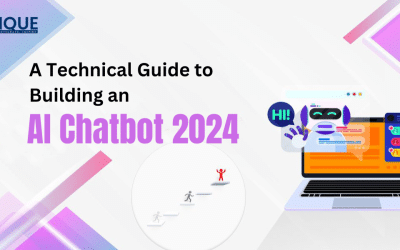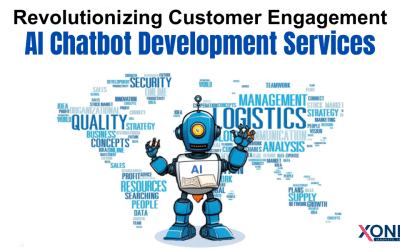In the ever-changing world of enterprise communications, integrating Natural Language Processing (NLP) applications has opened up a new age of sophisticated and customized interactions in chatbot systems. This paradigm shift is far beyond the standard Frequently Asked Questions (FAQs) to enter the realm of sophisticated interactions with people.
Companies strive to improve user engagement and simplify communications, so using NLP applications in chatbots has become a significant factor. This change is evident in the dynamic generation of content, context-aware responses, and a break from a rigid model of answering questions.
This research aims to reveal the complexities of NLP regarding chatbots for enterprises. It will look at the problems faced by traditional FAQs and offer new solutions. The journey covers various cutting-edge techniques that transform the user experience from personalized strategies to real-time adaptive.
Through the case studies and discussions of security and ethics, the debate traces the present and looks toward the future, illuminating the future of chatbots powered by NLP in enterprises.
Evolution of Enterprise Chatbots
The development of enterprise chatbots has been a dramatic shift from basic rule-based systems to sophisticated, contextually aware chatbots that utilize modern technologies, with the most important milestone being the introduction of Natural Language Processing (NLP). At first, chatbots were driven by rules and relied on predefined responses to specific questions. Although they were effective for simple tasks, they could not provide the ability to handle complex conversations.
The introduction of NLP was a major change in how chatbots understand and respond to input from natural language. This innovation allowed for more genuine and fluid interaction between bots and users. Sentiment analysis, entity recognition, and language understanding were integral elements, enabling chatbots to discern user intentions and context.
When machine-learning algorithms improved, chatbots evolved from static formats for answering questions to systems that learn through user interaction. They could alter their responses to historical data, making chats more personal. Furthermore, incorporating APIs (APIs) and other data sources widened the scope of chatbot capabilities.
The development also saw the development of multimodal capabilities that allow chatbots to process texts, images, gestures, and even voices. This broadened the scope of possibilities, including customer support, to tasks that require visual recognition. Through artificial intelligence, chatbots have evolved as intelligent digital assistants capable of proactively assisting users, anticipating their needs, and delivering an unmatched conversational experience.
In conclusion, the growth of chatbots for enterprises reflects the constant quest for better customer engagement and efficiency. From rule-based systems to NLP-driven conversational agents, each step is towards more efficient, flexible, and user-friendly interactions in the constantly changing enterprise communications landscape.
Understanding NLP in the Context of Chatbots
Knowing Natural Language Processing (NLP) in chatbots is crucial to unraveling the intricate human-computer interactions and increasing chatbots’ capabilities. NLP is a subfield within artificial intelligence, providing chatbots with the capability to understand, interpret, and create human-like languages that bridge the gap between user input and system logical responses.
In its essence, NLP involves the application of linguistic models and algorithms to deduce meaning from natural language data. In chatbots, machines can comprehend the literal meaning of words, the message’s intent, its sentiment, and the context of user messages.
The key elements of NLP chatbots are the ability to understand natural languages (NLU), which is focused on deriving the meaning from user inputs, and naturally generated language (NLG), which involves crafting coherent and contextually relevant responses to contextually relevant questions.
Chatbots powered by Natural Language Processing development can handle a range of linguistic complexities, from syntactic patterns to semantic details. Sentiment analysis, a fundamental component of NLP, lets chatbots detect users’ emotions, allowing for more compassionate and personalized interactions. Named Entity Recognition (NER) can further improve the understanding of chatbots by distinguishing entities such as names or dates and locations in conversations.
Additionally, the contextual understanding provided by NLP helps chatbots maintain a sense of coherence throughout conversations by analyzing their nature and duration. This contextual awareness helps create more natural and fluid exchanges and makes your experience with chatbots more natural and enjoyable.
Understanding NLP within conversational chatbots’ context is crucial to unlocking the full potential of these chatbots, allowing them to go beyond processing the language and comprehend and respond to the subtleties of human conversation.
Problems with traditional FAQs for Chatbots
Traditional frequently asked questions (FAQs) used by chatbots have been an essential element of user support by providing pre-defined answers to the most common questions. However, as expectations for users and conversational AI evolve, several issues arising from the dependence on traditional FAQs have been revealed.
One of the main issues is the static and rigid nature of the traditional FAQs. They have been pre-programmed with fixed answers, limiting their ability to adapt to the ever-changing nature of user questions. This inflexibility often causes frustration for users who require more specific, contextually-specific information that needs to be provided by pre-defined are-defined.
Another major issue is that more FAQs are needed to handle complex or open-ended inquiries. The users may not only sometimes be able to answer their questions simply, but the absence of understanding of natural language in the traditional FAQs hinders the chatbot’s ability to understand and respond accordingly.
Conventional FAQs also have maintenance problems. As products, processes, or services change and evolve, FAQs need manual updates to ensure they are up-to-date. This requires ongoing resources and delays in providing accurate information to customers.
Additionally, traditional FAQs can need help challenging to personalize. Users’ experiences differ, and a universal approach often fails to meet each individual’s needs. Personalization requires a sophisticated method to understand the preferences of users, something that the traditional FAQs could not provide.
In terms of engagement with users, traditional FAQs could lead to a less interactive and engaging experience. Today, users expect more responsive and dynamic interaction with chatbots. The limitations of FAQs can hinder the achievement of users’ expectations.
In conclusion, though traditional FAQs play a vital role in providing information, overcoming these issues requires a shift to more flexible and intelligent methods of communication, including Natural Language Processing (NLP) and machine learning, to ensure that chatbots can adapt to users’ ever-changing requirements.
The Role of Natural Language Processing (NLP) in Enhancing Conversations
The significance of Natural Language Processing (NLP) in improving conversations is crucial in bringing about a quantum improvement in the capabilities of chatbots and other AI systems that can be used in conversation.
NLP is a field of AI that allows machines to comprehend how to interpret and respond to human speech in a way that goes beyond simple keyword matching. Its importance is in its capacity to bridge the gap between humans and machines, allowing for greater natural, meaningful, and authentic interactions.
At its core, Natural Language Processing (NLP) enables chatbots to comprehend the subtleties of language, including context, intent, and mood. Instead of relying on predetermined patterns, NLP allows chatbots to understand the true meaning behind users’ questions and deliver more relevant, contextually relevant, and relevant responses.
One of the most important aspects of NLP is Natural Language Understanding (NLU), which is the process of obtaining meaning from user input. NLU lets chatbots discern the motive behind a question, identify the most important entities, and comprehend the relationship between the various components of the conversation. This level of understanding is vital to tailoring responses to individual users’ unique requirements and preferences.
Additionally, NLP facilitates Natural Language Generation (NLG), which allows chatbots to create consistent and appropriate responses to context. This is more than just giving static responses; it allows chatbots to create content based on current conversations, increasing the speed and naturality of conversations.
Enhancing the conversational experience, NLP also plays a crucial role in overcoming confusion about synonyms’ meanings and adapting to user language changes. As Chatbots become proficient in recognizing different ways people express themselves, leading to a more accessible and accommodating experience.
In essence, the function of NLP in enhancing conversation can be described as a fundamental shift to transform chatbots away from rule-based query-answer systems into intelligent agents capable of recognizing the context and adapting to respond in a way similar to human conversation. As technology continues to improve in the field of NLP, its integration into NLP is always at the forefront of developing seamless and immersive conversations.
Advanced NLP Techniques for Smarter Interactions
Advanced Natural Language Processing (NLP) techniques have brought about an era of more intelligent interactions, increasing the abilities of chatbots and virtual assistants. Moving beyond the basic understanding of language, they employ sophisticated algorithms and models that allow for more sophisticated, contextually aware conversations.
One of the most important NLP techniques is sentiment analysis, which allows chatbots to understand the emotions of user messages. By understanding the sentiment of messages, chatbots can adjust their responses to reflect users’ emotions better and provide an emotional and personal interaction. This is especially useful in customer support, as dealing with emotions can greatly enhance the user experience.
Named Entity Recognition (NER) is a crucial method that allows chatbots to classify and identify entities, such as the names of people, dates, places, and much more, that are part of the user’s queries. This increases the accuracy of information retrieval and allows chatbots to provide more precise and logically appropriate responses.
Contextual embeddings and language models, like the BERT (Bidirectional Encoder Representations from Transformers), have revolutionized Natural Language Processing services by taking in the relationships and contexts between the words in the sentence. This allows chatbots to comprehend the meanings of words in their particular context, leading to more precise understandings and responses, especially when dealing with complex or unclear queries.
Additionally, advanced techniques such as coreference resolution can help maintain the conversation’s context. Chatbots can track pronouns and references, which ensures a consistent and constant flow of dialogue. This feature is essential to creating a more natural, conversational experience reminiscent of a human.
In the end, advanced NLP techniques play a key role in creating more intelligent interactions in chatbots. Through sentiment analysis, contextual embeddings, NER, and coreference resolution, these techniques aid in the advancement of conversational AI, which allows chatbots to communicate with users at a level of comprehension and sensitivity previously thought to be beyond the realm of machines.
Personalization in Enterprise Chatbots: A NLP Approach
The ability to personalize chatbots for enterprises based on the Natural Language Processing (NLP) approach marks an important change in how user experiences are tailored to the individual’s preferences and requirements. Personalization based on NLP goes beyond standard answers and allows chatbots to change their behavior according to the user’s experience and current behavior.
The core of this method lies in Natural Language Understanding (NLU), an essential element of NLP. NLU allows chatbots to comprehend users’ queries and gain meaningful information about their preferences, intent, and past interactions. With this knowledge, chatbots can provide customized responses, recommendations, and solutions that perfectly match each user’s needs.
A key element of NLP-driven personalization is the use of contextual data. Chatbots can analyze the context of conversations, considering previous interactions and user-specific information to provide the most relevant and up-to-date information. This results in a personalized conversational experience for each user, creating a feeling of involvement and satisfaction.
Additionally, sentiment analysis in NLP lets chatbots assess the user’s mood. By recognizing and adjusting to the user’s mood, chatbots can increase personalization by responding sympathetically to the user’s mood and creating a more enjoyable interaction.
Named Entity Recognition (NER) can detect and recognize specific entities within the conversation, including names, products, or even places. Chatbots can provide specific recommendations or respond to queries with greater precision.
A personalized approach to NLP in chatbots in enterprises transforms these interactions into more relevant and customized experiences. By harnessing the potential of NLU, context analysis, sentiment understanding, and NER, chatbots can increase satisfaction, engagement, and overall efficiency in various settings within the enterprise.
Dynamic Content Generating Using NLP
Dynamic Content Generation using Natural Language Processing (NLP) marks a new era of creating contextually aware, adaptable, and personalized content in different applications, such as chatbots, content-recommending systems, and even chatbots. This new approach uses sophisticated technology and algorithms that dynamically create text that adapts to the context-specific conversation or query of the user.
One of the major advantages of dynamic content creation is the ability to go beyond static responses. Instead of relying on pre-defined content, NLP algorithms evaluate the context, intent of the user, and the available data to create relevant and customized on-the-fly responses. This increases the user’s engagement and ensures that the information you provide is accurate and up-to-date.
Context-awareness is an essential component of creating dynamic content. By analyzing how conversations unfold, NLP services algorithms can create content based on the previous questions and their preferences and change the conversation. This allows for an easier and more natural interaction, mimicking a human-like dynamic.
Additionally, NLP allows for different styles and tones in the generated content. For example, if the user is more inclined to use a formal or casual style, the dynamic content generation system can adapt to their preferences and create a more customized and enjoyable experience.
In chatbots or other applications, dynamic content generation allows instant responses to user inputs and more engaging and interactive conversations. It also helps communicate logically and consistently, increasing overall communication efficiency.
Dynamic content creation using NLP can help systems surpass static responses and provide an adaptive and more personalized user experience. This method is revolutionizing the understanding of natural language and helping create more responsive and intelligent applications across various areas.
Enhancing Engagement of Users through Context-aware Reactions
Engaging users with contextually aware responses is an innovative method that uses advanced technology, including Natural Language Processing (NLP), to provide more engaging and personal interactions. Context-aware interactions require a thorough understanding of the current conversation, the user’s history, and the larger context to provide pertinent and up-to-date information, resulting in a more enjoyable user experience.
One of the most important aspects of this method key to this approach is Natural Language Understanding (NLU) in NLP. NLU allows systems to understand the subtleties of user queries and determine intent, entities, and sentiments. By incorporating this knowledge into responses, chatbots, and virtual assistants can modify their responses to match the individual user’s preferences and needs, resulting in more relevant and contextually appropriate interactions.
Real-time contextual analysis is a second vital component. As conversations progress, the system constantly evaluates the context and adjusts responses according to the current conversation. This assures that the information is up-to-date and relevant and contributes to an easier and more natural flow of conversations.
The user’s history and preferences are also essential in contextually aware responses. By analyzing previous encounters, the software will provide personalized recommendations, keep track of the user’s preferences, and deliver an experience that is more centered around the user. This improves the user’s experience by making it appear tailored to the particular user.
In customer support, chatbots can use context-aware responses to refer to previous queries from users to avoid redundancy and provide an efficient and enjoyable user experience. This results in a conversational interface that can not only comprehend users’ input but also respond in a manner that reflects a complete understanding of the current context, which, in turn, increases users’ engagement.
Beyond Text: Leveraging NLP for Multimodal Conversations
Beyond the textual, the use of Natural Language Processing (NLP) for multimodal conversation is significant progress in the realm of communications between humans and machines. Multimodal interactions do not just include the exchange of text but also auditory and visual elements, which allows for an immersive and richer user experience.
NLP Development plays a key function in multimodal conversation by broadening its capabilities beyond the processing of text to comprehending and creating content that can be used in various modalities. Visual elements, like videos and images, could be examined using computer vision techniques and integrated with NLP Development, which allows chatbots to understand and respond to input from the visual. This opens the door to applications ranging from image recognition to contextual and based visual information.
Furthermore, the combination of NLP and the speech recognition system helps in the comprehension and generation of speech. This allows chatbots to participate in conversations with people, which makes interactions more natural and attainable. Multimodal conversational agents can process both speech and text inputs and respond consistently and contextually.
The power of NLP for multimodal conversation is its ability to connect different modes, resulting in a comprehensive comprehension of user input. For instance, a person may describe a visual idea in textual form. NLP helps chatbots understand and respond accordingly in a seamless way, combining data from different modalities.
In the end, using NLP for multimodal conversations is a step beyond the limits of text-based interactions, creating a flexible and inclusive communication platform. This innovation not only enhances the user experience but also provides access to a wide variety of applications, ranging from visual understanding of content to more authentic and immersive interactions via chatbots.
Real-time Adaptability and Learning in Chatbots
The ability to learn and adapt in real-time are two key aspects that differentiate modern chatbots, allowing them to evolve and improve their performance over regular interactions continuously. This capability transforms the way chatbots interact with users. Modern technology, specifically algorithmic machine learning and Natural Language Processing NLP, is used to improve the responsiveness of chatbots, making them more aware of context and more efficient as time passes.
Real-time adaptiveness refers to the chatbot’s ability to alter its responses based on the present situation. NLP plays a crucial part in this process, making it possible for the chatbot to comprehend the user’s intent, sentiments, and context-specific cues as the conversation develops. This flexibility assures that the chatbot can provide accurate and timely information even in response to changing queries from users.
Chatbot learning is a continuous process that is driven by machine-learning algorithms. These algorithms study the user’s interactions, feedback, and historical data to enhance the chatbot’s capabilities. When confronted with new questions, the chatbot learns through each interaction, improving its ability to comprehend and respond. This process of learning continues over time and aids in the chatbot’s ability to respond to a broader range of questions and to adjust to the preferences of users as time passes.
The ability to adapt and learn in real time is especially valuable in environments where users’ needs may alter or where the chatbot is used to perform a variety of tasks. This improves the chatbot’s flexibility and ensures that it is relevant and efficient in meeting customer needs as they change, whether for virtual assistance, customer support, or other areas.
In the end, the combination of real-time adaptiveness and learning allows chatbots to transcend static responses and become more responsive, aware of context, and capable of delivering customized and dependable conversation interactions.
Measuring Success: Metrics for Evaluating Advanced Conversational Experiences
The measurement of the effectiveness of sophisticated conversational experiences requires the use of a variety of metrics that are beyond the traditional indicators of performance. These metrics reflect the complexity of the interactions facilitated by technology such as Natural Language Processing (NLP) and advanced chatbots.
User Satisfaction:
- Rating System: Collecting user comments via ratings following interactions is an immediate satisfaction measurement.
- Evaluation of Sentiment: Analyzing the user’s sentiments during conversations can help determine the emotions that result from them.
Contextual Understanding:
- Quality of Intent: Characterizing the ability of chatbots to identify accurately the user’s intent, it demonstrates its expertise in responding to various inquiries.
- Content Retention Examines the extent to which the chatbot’s understanding of a conversation’s context reflects its comprehension of the context.
Engagement Metrics:
- Session Time: Session durations that are longer usually indicate continued user engagement.
- Interactive Depth The analysis of the user’s interactions shows the chatbot’s ability to provide complete responses.
Personalization:
- Personalized Recommendations Analyzing the chatbot’s capability to provide personalized suggestions according to the user’s preferences.
- Use of User Profiles: Assessing how well the chatbot uses user information to customize responses to each user’s demands.
Efficiency and Resolution:
- First-Contact Resolution The percentage of queries from users resolved in the first contact indicates the effectiveness.
- Response Time Monitoring time is required to respond to user queries, which improves overall effectiveness.
Learning and Adaptability:
- Improvement over time: Monitoring the chatbot’s improvement in performance based on its iterative learning.
- Flexibility to New Inputs: Assessing how well the chatbot can handle new inputs and adjust to new inputs and responses in real-time.
Combining these metrics can help organizations gain an overall understanding of the effectiveness of sophisticated conversational experiences, allowing them to continuously improve and optimize chatbots’ performance to meet changing customer expectations and goals.
Security and Ethics in NLP-driven Chatbot Interactions
Ethics and security are crucial to chatbots that NLP development Companies use since the application of new technologies creates concerns about the security of data, privacy for users, and the ethical application of artificial intelligence. Addressing these concerns is crucial to ensuring that chatbot conversations are in line with ethical guidelines and creating an environment that is secure for users.
Privacy Protection
The protection of users’ privacy is the foundation of ethical chatbot interaction. Companies must take strong measures to safeguard users’ data, including security protocols for encryption, safe storage of data, and conformity with data protection regulations such as GDPR and HIPAA. Transparent privacy policies and consent mechanisms are essential to maintaining and building confidence in the user.
Bias Mitigation
Ethics concerns are raised when NLP models are inadvertently biased by biases present in the training data. The developers must actively work to detect and reduce biases to ensure fair and impartial treatment of users regardless of demographics. Regular audits and monitoring are crucial to address bias issues that can arise over time.
User Consent and Control
Ethics-based chatbot interactions require clear information about data usage and the user’s consent. Users should be in control of the data they provide and be aware of how their data is used. Opt-in and out mechanisms allow users to make informed decisions about their interactions with chatbots.
Security Measures
Implementing robust security measures is crucial to safeguarding against potential vulnerabilities. These include regularly scheduled security inspections, the encryption of sensitive information, and following industry best practices for secure coding and deployment.
Transparency and Explainability
Chatbots must be created with transparency in mind. Users must be aware that they’re communicating with a chatbot, not a person. Furthermore, developers should consider explanations, which allow users to comprehend the reasoning behind decisions made by the chatbot.
In short, prioritizing security and ethics in chatbots requires a complete approach that includes security of privacy, bias reduction of users’ consent, strong security measures, and openness. By adhering to these standards, companies can promote ethical practices when it comes to the creation and implementation of chatbots and help ensure their security and trustworthiness for their users.
Future Trends: What’s Next for NLP and Advanced Conversational Experiences
What lies ahead for Natural Language Processing (NLP) and advanced conversations offers exciting possibilities fueled by the constant advancement of technology and the emergence of new technologies. A variety of trends are expected to change the landscape over the next decade:
Conversational AI Maturity
Expect a development in chatbots as they become more sophisticated virtual assistants able to handle complex tasks, comprehend the context in extended interactions, and demonstrate greater emotional intelligence.
Multimodal Interactions
The combination of NLP Application Development Services, advanced speech recognition, and computer vision technology will result in more seamless interactions across multiple modes. Chatbots can comprehend and produce text as well as videos, images, and spoken languages, providing a more immersive user experience.
Zero-shot Learning
Innovations in NLP models will allow zero-shot learning, which allows chatbots to understand and respond to questions about topics they’ve never been specifically taught about. This will increase the flexibility and adaptability of AI-based conversation systems.
Explainable AI
A growing emphasis on developing explicable AI algorithms will resolve the issues about the clarity and comprehensibility of NLP-driven models. Building trust and understanding how AI makes specific decisions or actions is vital.
Enhanced Personalization
In the future, chatbots will utilize more user data, behavioral analytics, and advanced machine learning techniques to deliver highly personalized experiences. This will include anticipating user demands and preferences and adjusting responses accordingly.
Edge Computing for Chatbots
Integrating edge computing and chatbots will decrease latency, allowing quicker and more efficient interactions. This is crucial for applications that require real-time, fast, and precise responses are essential.
Conversational Search and Navigation
NLP advances will transform the way people interact with search engines and find information. Conversational search will become nimbler, allowing users to search for relevant information using natural language queries.
Domain-Specific Chatbots
Chatbots designed for specific sectors or areas are expected to become more commonplace. They will possess deep knowledge and a deep understanding of specific areas and provide specific and accurate details.
In short, the upcoming developments of NLP and advanced conversation experiences will bring about a new age of more sophisticated, adaptive, and human-like interaction. As technology advances and improves, AI-based conversation capabilities will improve, delivering enhanced and customized user experiences across various industries and applications.
The Key Takeaway
In the end, the investigation of advanced conversations driven through Natural Language Processing (NLP) opens up a new world where chatbots go beyond static interactions and become more interactive, contextually aware, and seamlessly integrated with different modes of communication. The process involves overcoming the challenges presented by traditional FAQs, harnessing the capabilities of NLP to create personalized multimodal conversations, and incorporating ethical considerations into every conversation.
As companies look to the future, indicators of success will become more complex and include factors such as user satisfaction, understanding of context, and flexibility. The incorporation of NLP Development Services will not only increase user engagement but also facilitate real-time learning, making chatbots more efficient and agile in the long run.
Security, ethics, and transparency are crucial to building trust among users. As we look ahead, the latest trends in NLP, such as multimodal interactions, explicable AI, and improved personalization, indicate the future of chatbots that easily integrate into our everyday lives, providing intelligent and personalized experiences in different fields.











